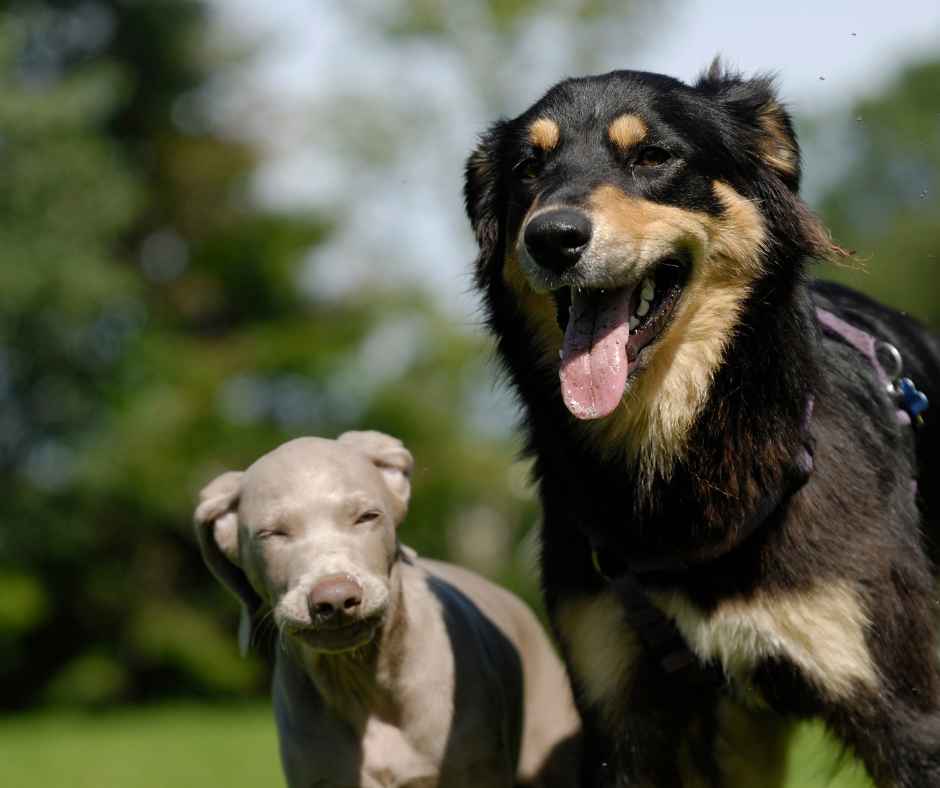You often think your dog is friendly, but that is not always true. Your four-legged creature may be good at home only. However, the doggo starts to get aggressive when you take it out. That may give rise to confusion, and you end up frustrated, thinking about how to know if your dog is dog friendly!

So let’s answer!
Is your dog friendly? How can you tell if your furry friend is open and welcoming to others?
How do I know if my dog is friendly with other dogs?
Of course, dogs belong to a different species. They cannot talk to explain what’s going on in their minds. Their body language does the total communication. Thus, understanding it is the key to knowing whether your dog is friendly to other dogs.
In addition, it would also help to know whether your pup is okay in the presence of strangers or other little-familiar people.
Moreover, learning about a dog’s body language isn’t only beneficial for you as a pet owner, but it offers other advantages too. For example, it will help you to read the behaviors of others’ dogs and take cautionary measures if needed.
Hence, let’s uncover the subject to comprehend doggies’ behavior towards their canine fellows and the homo sapiens.
Is Your Dog Too Friendly? Signs Your Dog Is Friendly with Other Dogs

Some signs that indicate the friendliness of the furry creatures are as follows;
Unleash Love: How a Play Bow Reveals Your Dog’s Friendliness
The play bow signals that dogs invite another canine or human to play with them. It means the dog is friendly towards you or its furry fellows. Each dog has a different way of giving the signal depending on its breed and experiences.
However, during the signal, the rear end of the four-legged animal is usually up, and its front end is down.
Decoding Dog Friendliness: Loose Tail Wag Explained
How do you know if a dog is friendly? Loose tail wag tells you! It’s a sign of a canine’s friendliness. Loose tail wagging is defined as a dog’s tail movement so that the tail is neither too high nor too low.
It usually signifies that a puppy is comfortable and cordial in the presence of strangers or other doggies.
Moreover, a gentle wagging with the mouth slightly open or wiggling of the hips also indicates the dog’s friendliness. However, distinguish loose wag from a slow tail wagging. The latter is a sign of unfriendliness, so it’s better to be cautious when you witness it.
Rolling on Back: A Complex Canine Behavior You Need to Know About
A canine rolling on its back generally means it is not a threat to anyone. You usually see this behavior when your pet meets another furry creature. Rolling on the back is the dog’s saying: “I am not going to hurt this fellow doggie.”
In addition, the furry creatures expose their vulnerable underside while rolling on their backs. Thus, showing their love and friendly nature for their canine companions.
Curved Paths: A Sign of Your Dog’s Friendliness?
Another sign indicating a dog’s friendliness is taking a curved path when it approaches another four-legged animal. Direct eye contact is a big no for your pet if it’s cordial. Hence, such a furry creature is not a threat as it follows the right manners of friendliness and greeting used in the doggy world.
Is Your Dog Not Too Friendly? Signs Your Dog Is Not Friendly with Other Dogs
How to know if your dog is dog friendly? Also, how to tell if your neighbor’s dog is not posing a threat? The signs of unfriendliness are another way to judge whether a furry creature is cordial. Thus, the following are some common signals;
Decode Your Dog’s Body Language: High Tail Wag and Friendliness
A high, stiff tail wag indicates the dog’s aggressiveness and irritation. When a dog is annoyed, uncertain, or fearful, it wags its tail in this manner. Your canine may end up biting a stranger or another dog it encountered after manifesting a high wag.
Also, it’s essential to know that the higher the tail, the greater danger it poses. Furthermore, this high wag also releases the doggy’s scent from the anal glands. This way, it marks its territory. In addition, a low-hung wagging tail also indicates the doggy’s unfriendliness.
Direct Eye Contact in Dogs: Friendly or Threatening?
Direct eye contact is considered rude in the doggy world. Thus, it’s not a good sign if you see your dog approaching another furry creature on a straight path while directly staring at it. In addition, the alert tail accompanying a hard stare is also not okay.
Your pet is probably challenging another doggo through this behavior and certainly not excited to greet it.
Is Your Dog Friendly? Beware of Bared Teeth – Signs to Look for
Bared teeth in dogs generally show aggression. Canines are asking you and other doggies to back off through this behavior. It’s a warning by the dogs that they will use their teeth to bite whoever is annoying them. Moreover, this behavior often accompanies growling, snarling, stiffness, erected ears, etc. There can be multiple reasons behind this aggression.
For example, fear, pain, resource guarding, territoriality, and overstimulation can make the hound aggressive. In such a situation, it’s better not to make eye contact with the dog and carefully step away from that place. You should also take professional help promptly before the canine bites you or anyone else.
Dog’s Growling: A Sign of Unfriendliness or Playfulness?
The three types of growling that can show a dog’s unfriendliness are threat growling, aggressive growling, and fight growling. The first occurs when a canine wants to maximize the distance between itself and perceived danger. In doing so, the dog may bite an individual or another doggo.
Aggressive growling means the furry creature wants to minimize the space between itself and the object of aggression. It can attack both humans and other doggies. Finally, fight growling occurs when two dogs are fighting with each other.
However, two more growling types are mistaken for signs of aggression or threat. But they are harmless. Those two types are;
- Pleasure growling
- Play growling
Canine Temperament Test: How to Determine if Your Dog Is Friendly
How to know if your dog is dog friendly? Temperament testing is one of the professional ways to answer this query. The test informs you about the canines’ general attitude towards humans and other animals. Their attitude is affected by both genetic and environmental factors.
The test in four-legged creatures is usually carried out for breeders and rescue organizations. However, a dog owner can also go for it. Moreover, the testing evaluates many other things, along with friendliness. It also checks the dog’s level of aggression, prey drive, stability, etc.
The test can include a short walk through a park or neighborhood. Auditory, visual, and tactile stimuli are used during the walk to let the behaviorist assess your dog’s temperament. The behaviorist checks whether the canine can differentiate between a threatening and non-threatening situation.
Moreover, your furry baby automatically fails the test if it demonstrates unprovoked aggression, strong avoidance, or panic without recovery.
Canine Temperament Test with Strangers and Other Dogs
The test also includes reading your dog’s attitude with strangers and other four-legged fellows.
- Your canine’s temperament with strangers: The two types of strangers are used in the test: a neutral stranger and a friendly stranger. However, only the latter informs about the canine’s friendliness. During the evaluation, the friendly stranger comes and nicely greets the handler. Then the stranger pets the doggo. Consequently, the dog’s response and behavior inform the behaviorist about the doggy’s social skills.
- Your canine’s temperament with other dogs: During the test, your dog is left to play with other furry fellows. This way, the behaviorist evaluates your pet’s conduct, body language, and personality with other dogs. Generally, the expert checks whether your hound is aggressive or friendly towards other four-legged creatures.
Indeed, canine owners can perform temperament testing at home, but it is tough for the average doggy parent. Thus, consulting a canine behaviorist is your best bet, especially if you are uncomfortable or uncertain about how to conduct the test. Doing so will help produce more accurate results.
Moreover, if you perform the test incorrectly, then things can go in a negative direction. Most importantly, do not conduct the aggression test at home. That’s because your dog may get out of control during evaluation. Eventually, you will be in danger.
From Unfriendly to Friendly: How to Train Your Dog’s Temperament

How do I know if my dog is friendly with other dogs and humans? You got your answers right! However, if you think your pet is unfriendly or aggressive, there is appropriate training for such canines.
First and foremost, book an appointment with a veterinarian. They can tell better why your dog demonstrates aggression in certain circumstances. Next, consult a certified canine behavior consultant if the veterinarian detects no issue.
However, avoid going to an average dog trainer, for they lack proper knowledge and experience handling such dogs.
A certified consultant will develop a proper behavior modification plan. That will assist you in working on your canine’s behavior issues. As a result, it may stop being unfriendly towards strangers and other dogs.
Lastly, today, we live in a world that is becoming more aware of animal rights. As a result, dogs are hugely accepted in society now. However, you cannot co-exist with these furry creatures without proper knowledge about them.
Thus, learning about signs of a dog’s friendliness and unfriendliness is significant too. This way, you can help create a safe world for both humans and doggies.
Frequently Asked Questions: How to Know If Your Dog Is Dog-Friendly – Expert Insights
Observe your dog’s body language and behavior around other dogs. Signs of dog friendliness include a loose, wiggly body, relaxed facial expressions, and playfulness. Signs of unfriendliness include tense body language, growling, bared teeth, and aggression.
To make sure your dog is friendly, you can socialize them early on with other dogs and people. Monitor their behavior and training regularly to prevent them from being too friendly or unfriendly towards others.
To tell if a dog is friendly or aggressive, observe their body language, socialization skills, and behavior around people and other animals. If your dog is friendly, it may exhibit signs such as loose body language, a wagging tail, and a relaxed face. However, if your dog is aggressive, it may display signs such as bared teeth, growling, and raised fur.
To know if your puppy is friendly, observe their body language, and introduce them to new experiences and people early on to socialize them. Remember to always supervise interactions with other dogs and humans.
